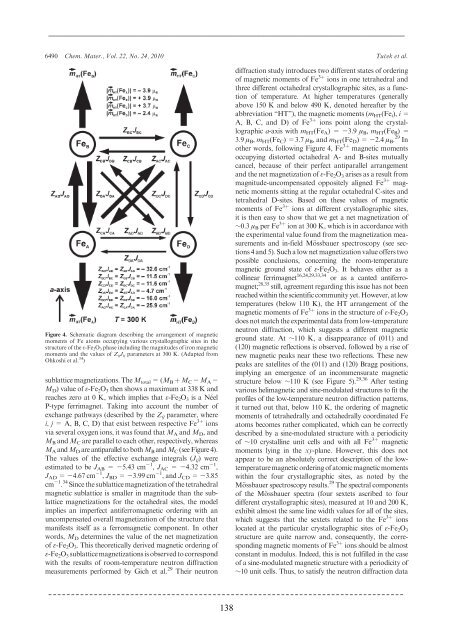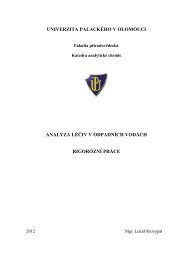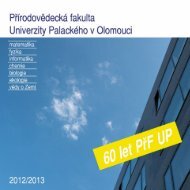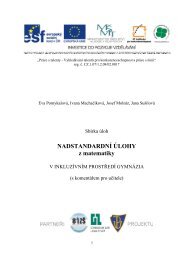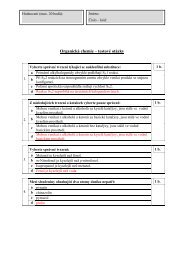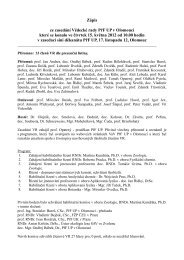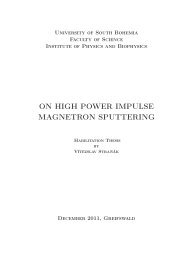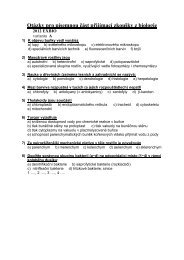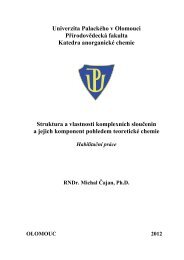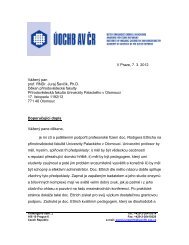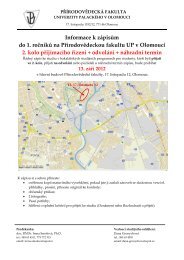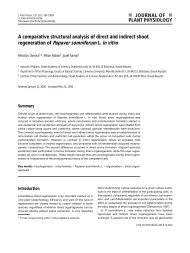ε-Fe2O3: An Advanced Nanomaterial Exhibiting Giant Coercive ...
ε-Fe2O3: An Advanced Nanomaterial Exhibiting Giant Coercive ...
ε-Fe2O3: An Advanced Nanomaterial Exhibiting Giant Coercive ...
You also want an ePaper? Increase the reach of your titles
YUMPU automatically turns print PDFs into web optimized ePapers that Google loves.
______________________________________________________________________________<br />
6490 Chem. Mater., Vol. 22, No. 24, 2010 Tucek et al.<br />
Figure 4. Schematic diagram describing the arrangement of magnetic<br />
moments of Fe atoms occupying various crystallographic sites in the<br />
structure of the ε-Fe 2 O 3 phase including the magnitudes of iron magnetic<br />
moments and the values of Z ij J ij parameters at 300 K. (Adapted from<br />
Ohkoshi et al. 34 )<br />
sublattice magnetizations. The M total =(M B þ M C - M A -<br />
M D ) value of ε-Fe 2 O 3 then shows a maximum at 338 K and<br />
reaches zero at 0 K, which implies that ε-Fe 2 O 3 is a Neel<br />
P-type ferrimagnet. Taking into account the number of<br />
exchange pathways (described by the Z ij parameter, where<br />
i, j =A,B,C,D)thatexistbetweenrespectiveFe 3þ ions<br />
via several oxygen ions, it was found that M A and M D ,and<br />
M B and M C are parallel to each other, respectively, whereas<br />
M A and M D are antiparallel to both M B and M C (see Figure 4).<br />
The values of the effective exchange integrals (J ij )were<br />
estimatedtobeJ AB = -5.43 cm -1 , J AC = -4.32 cm -1 ,<br />
J AD = -4.67 cm -1 , J BD = -3.99 cm -1 ,andJ CD = -3.85<br />
cm -1 . 34 Since the sublattice magnetization of the tetrahedral<br />
magnetic sublattice is smaller in magnitude than the sublattice<br />
magnetizations for the octahedral sites, the model<br />
implies an imperfect antiferromagnetic ordering with an<br />
uncompensated overall magnetization of the structure that<br />
manifests itself as a ferromagnetic component. In other<br />
words, M D determines the value of the net magnetization<br />
of ε-Fe 2 O 3 . This theoretically derived magnetic ordering of<br />
ε-Fe 2 O 3 sublattice magnetizations is observed to correspond<br />
with the results of room-temperature neutron diffraction<br />
measurements performed by Gich et al. 29 Their neutron<br />
diffraction study introduces two different states of ordering<br />
of magnetic moments of Fe 3þ ions in one tetrahedral and<br />
three different octahedral crystallographic sites, as a function<br />
of temperature. At higher temperatures (generally<br />
above 150 K and below 490 K, denoted hereafter by the<br />
abbreviation “HT”), the magnetic moments (m HT (Fe i ), i =<br />
A, B, C, and D) of Fe 3þ ions point along the crystallographic<br />
a-axis with m HT (Fe A )=-3.9 μ B , m HT (Fe B )=<br />
3.9 μ B , m HT (Fe C )=3.7μ B ,andm HT (Fe D )=-2.4 μ B . 29 In<br />
other words, following Figure 4, Fe 3þ magnetic moments<br />
occupying distorted octahedral A- and B-sites mutually<br />
cancel, because of their perfect antiparallel arrangement<br />
and the net magnetization of ε-Fe 2 O 3 arises as a result from<br />
magnitude-uncompensated oppositely aligned Fe 3þ magnetic<br />
moments sitting at the regular octahedral C-sites and<br />
tetrahedral D-sites. Based on these values of magnetic<br />
moments of Fe 3þ ions at different crystallographic sites,<br />
it is then easy to show that we get a net magnetization of<br />
∼0.3 μ B per Fe 3þ ionat300K,whichisinaccordancewith<br />
the experimental value found from the magnetization measurements<br />
and in-field M€ossbauer spectroscopy (see sections<br />
4 and 5). Such a low net magnetization value offers two<br />
possible conclusions, concerning the room-temperature<br />
magnetic ground state of ε-Fe 2 O 3 . It behaves either as a<br />
collinear ferrimagnet 16,24,29,33,34 or as a canted antiferromagnet;<br />
28,35 still, agreement regarding this issue has not been<br />
reached within the scientific community yet. However, at low<br />
temperatures (below 110 K), the HT arrangement of the<br />
magnetic moments of Fe 3þ ions in the structure of ε-Fe 2 O 3<br />
does not match the experimental data from low-temperature<br />
neutron diffraction, which suggests a different magnetic<br />
ground state. At ∼110 K, a disappearance of (011) and<br />
(120) magnetic reflections is observed, followed by a rise of<br />
new magnetic peaks near these two reflections. These new<br />
peaks are satellites of the (011) and (120) Bragg positions,<br />
implying an emergence of an incommensurate magnetic<br />
structure below ∼110 K (see Figure 5). 29,36 After testing<br />
various helimagnetic and sine-modulated structures to fit the<br />
profiles of the low-temperature neutron diffraction patterns,<br />
it turned out that, below 110 K, the ordering of magnetic<br />
moments of tetrahedrally and octahedrally coordinated Fe<br />
atoms becomes rather complicated, which can be correctly<br />
described by a sine-modulated structure with a periodicity<br />
of ∼10 crystalline unit cells and with all Fe 3þ magnetic<br />
moments lying in the xy-plane. However, this does not<br />
appear to be an absolutely correct description of the lowtemperature<br />
magnetic ordering of atomic magnetic moments<br />
within the four crystallographic sites, as noted by the<br />
M€ossbauer spectroscopy results. 29 The spectral components<br />
of the M€ossbauer spectra (four sextets ascribed to four<br />
different crystallographic sites), measured at 10 and 200 K,<br />
exhibit almost the same line width values for all of the sites,<br />
which suggests that the sextets related to the Fe 3þ ions<br />
located at the particular crystallographic sites of ε-Fe 2 O 3<br />
structure are quite narrow and, consequently, the corresponding<br />
magnetic moments of Fe 3þ ions should be almost<br />
constant in modulus. Indeed, this is not fulfilled in the case<br />
of a sine-modulated magnetic structure with a periodicity of<br />
∼10 unit cells. Thus, to satisfy the neutron diffraction data<br />
¯ ¯ ¯ ¯ ¯ ¯ ¯ ¯ ¯ ¯ ¯ ¯ ¯ ¯ ¯ ¯ ¯ ¯ ¯ ¯ ¯ ¯ ¯ ¯ ¯ ¯ ¯ ¯ ¯ ¯ ¯ ¯ ¯ ¯ ¯ ¯ ¯ ¯ ¯ ¯ ¯ ¯ ¯ ¯ ¯ ¯ ¯ ¯ ¯ ¯ ¯<br />
¯ ¯ ¯ ¯ ¯ ¯ ¯ ¯ ¯ ¯ ¯ ¯ ¯ ¯ ¯ ¯ ¯ ¯ ¯ ¯ ¯ ¯ ¯ ¯ ¯ ¯ ¯<br />
138


